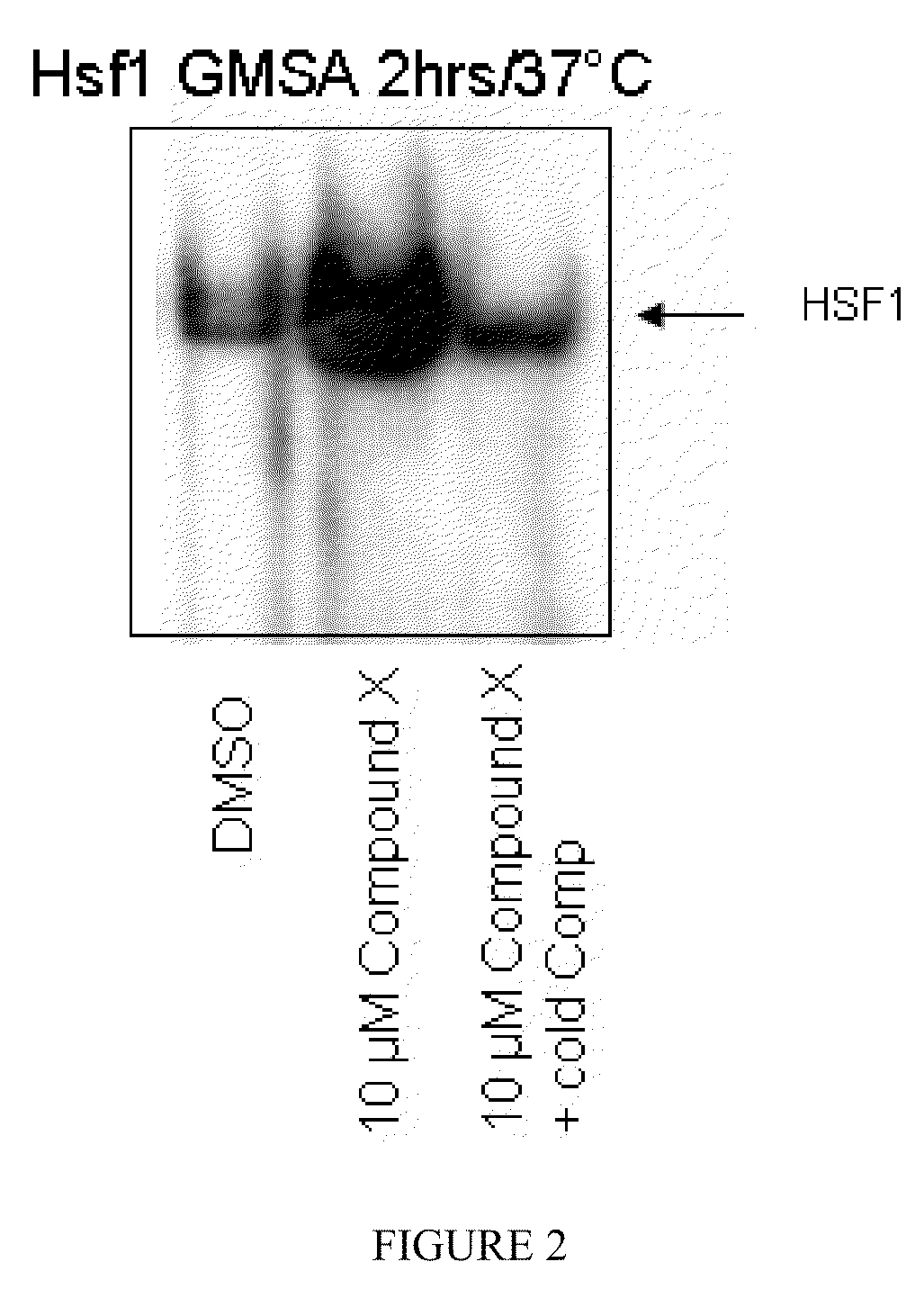Indole compounds and their use as radiation sensitizing agents and chemotherapeutic agents
a technology of indole compounds and sensitizing agents, which is applied in the field of radiation sensitizers, can solve the problems of difficult to achieve such temperatures in tumors, limited clinically, and high toxicities at high concentrations, and achieve the effects of improving the effect of cancer radiotherapy, improving radiation sensitivity, and low sensitivity
- Summary
- Abstract
- Description
- Claims
- Application Information
AI Technical Summary
Benefits of technology
Problems solved by technology
Method used
Image
Examples
example 1
[0097]
4-((3-((2,4,6-trioxotetrahydropyrimidin-5(6H)-ylidene)methyl)-1H-indol-1-yl)meth-yl)benzonitrile (1)
[0098]A mixture of barbituric acid (1.28 g; 0.01 mol) and 4-((3-formyl-1H-indol-1-yl)methyl)benzonitrile (2.60 g; 0.01 mol) in methanol (50 ml) were stirred at room temperature. After 10 min the reaction mixture became a solid suspension and the color of reaction mixture changed to yellow color solid suspension. The suspension continued to stir at room temperature for 5 hrs. Solid product was separated by filtration and washed several times with cold methanol (3×5 ml). The isolated yellow solid recrystallized from methanol gave (1) as a yellow crystalline product; m.p. >300° C.; 1H NMR (DMSO-d6): δ 5.81 (s, 2H), 7.33-7.36 (m, 2H), 7.43-7.45 (d, 2H), 7.61-7.64 (m, 1H), 7.82-7.84 (d, 2H), 7.90-7.93 (m, 1H), 8.68 (s, 1H), 9.63 (s, 1H), 11.07 (bs, 1H), 11.15 (bs, 1H); 13C NMR (DMSO-d6): δ 49.7, 109.4, 110.5, 110.8, 111.8, 117.9, 118.4, 123.0, 123.8, 128.0, 129.6, 132.6, 136.1, 141.7...
example 2
[0099]
Methyl-4-((3-((2,4,6-trioxotetrahydropyrimidin-5(6H)-ylidene)methyl)-1H-indol-1yl)methyl)benzoate (2)
[0100]A mixture of barbituric acid (1.28 g; 0.01 mol) and methyl 4-((3-formyl-1H-indol-1-yl)methyl)benzoate (2.93 g; 0.01 mol) in methanol (50 ml) were stirred at room temperature. After 10 min the reaction mixture became a solid suspension and the color of reaction mixture changed to yellow color solid suspension. The suspension continued to stir at room temperature for 5 hrs. Solid product was separated by filtration and washed several times with cold methanol (3×5 ml). The isolated yellow solid recrystallized from methanol gave (2) as a yellow crystalline product; m.p. >300° C.; 1H NMR (DMSO-d6): δ 3.82 (s, 3H), 5.79 (s, 2H), 7.33-7.36 (m, 2H), 7.40-7.42 (d, 2H), 7.61-7.63 (m, 1H), 7.91-7.93 (m, 1H), 7.94-7.95 (d, 2H), 8.68 (s, 1H), 9.62 (s, 1H), 11.06 (bs, 1H), 11.14 (bs, 1H); 13C NMR (DMSO-d6): δ 49.9, 52.1, 109.2, 110.7, 111.8, 117.8, 122.9, 123.7, 127.4, 129.0, 129.5, 12...
example 3
[0101]
(Z)-4-((3-((2,5-dioxoimidazolidin-4-ylidene)methyl)-1H-indol-1-yl)methyl)benzo nitrile (7)
[0102]A mixture of hydantoin (1.00 g; 0.01 mol), 4-((3-formyl-1H-indol-1-yl)methyl)benzonitrile (2.60 g; 0.01 mol) and ammonium acetate (0.77 g; 0.01 mol) in acetic acid (2.70 g; 0.045 mol) were refluxed for 10 hrs. The reaction mixture was cooled and water (20 ml) was added. Filtered the product and washed with cold water (2×5 ml). The crude product was recrystallized from a mixture of methanol and ethyl acetate (1:1 v / v) gave (3) as a yellow crystalline product; m.p. >300° C.; 1H NMR (DMSO-d6): δ 5.56 (s, 2H), 6.73 (s, 1H), 7.13-7.23 (m, 2H), 7.44-7.46 (d, 2H), 7.51-7.53 (d, 1H), 7.56 (m, 3H), 8.30 (s, 1H), 10.15 (bs, 1H), 11.07 (bs, 1H); 13C NMR (DMSO-d6): δ 49.8, 100.4, 118.2, 110.4, 111.8, 118.2, 120.4, 122.5, 124.2, 126.8, 128.4, 129.9, 130.2, 134.8, 142.6, 142.6, 154.8, 164.8.
Experimental Protocols
Plating Efficiency (PE)
[0103]Human colon carcinoma cells (HT-29) were grown in DMEM / F...
PUM
| Property | Measurement | Unit |
|---|---|---|
| temperature | aaaaa | aaaaa |
| particle size | aaaaa | aaaaa |
| pH | aaaaa | aaaaa |
Abstract
Description
Claims
Application Information
 Login to View More
Login to View More - R&D
- Intellectual Property
- Life Sciences
- Materials
- Tech Scout
- Unparalleled Data Quality
- Higher Quality Content
- 60% Fewer Hallucinations
Browse by: Latest US Patents, China's latest patents, Technical Efficacy Thesaurus, Application Domain, Technology Topic, Popular Technical Reports.
© 2025 PatSnap. All rights reserved.Legal|Privacy policy|Modern Slavery Act Transparency Statement|Sitemap|About US| Contact US: help@patsnap.com



